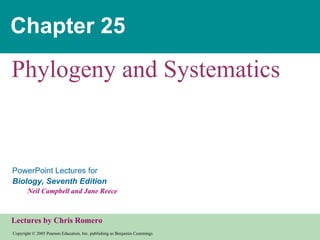Denunciar
Compartir

Recomendados
Más contenido relacionado
La actualidad más candente
La actualidad más candente (20)
Phylogenetic tree and its construction and phylogeny of

Phylogenetic tree and its construction and phylogeny of
Similar a Chapter25
Similar a Chapter25 (20)
Ap Chapter 26 Evolutionary History Of Biological Diversity

Ap Chapter 26 Evolutionary History Of Biological Diversity
Último
Último (20)
PLAI - Acceleration Program for Generative A.I. Startups

PLAI - Acceleration Program for Generative A.I. Startups
Future Visions: Predictions to Guide and Time Tech Innovation, Peter Udo Diehl

Future Visions: Predictions to Guide and Time Tech Innovation, Peter Udo Diehl
Introduction to FDO and How It works Applications _ Richard at FIDO Alliance.pdf

Introduction to FDO and How It works Applications _ Richard at FIDO Alliance.pdf
Agentic RAG What it is its types applications and implementation.pdf

Agentic RAG What it is its types applications and implementation.pdf
Secure Zero Touch enabled Edge compute with Dell NativeEdge via FDO _ Brad at...

Secure Zero Touch enabled Edge compute with Dell NativeEdge via FDO _ Brad at...
What's New in Teams Calling, Meetings and Devices April 2024

What's New in Teams Calling, Meetings and Devices April 2024
Buy Epson EcoTank L3210 Colour Printer Online.pptx

Buy Epson EcoTank L3210 Colour Printer Online.pptx
Choosing the Right FDO Deployment Model for Your Application _ Geoffrey at In...

Choosing the Right FDO Deployment Model for Your Application _ Geoffrey at In...
The Value of Certifying Products for FDO _ Paul at FIDO Alliance.pdf

The Value of Certifying Products for FDO _ Paul at FIDO Alliance.pdf
Introduction to Open Source RAG and RAG Evaluation

Introduction to Open Source RAG and RAG Evaluation
Integrating Telephony Systems with Salesforce: Insights and Considerations, B...

Integrating Telephony Systems with Salesforce: Insights and Considerations, B...
Optimizing NoSQL Performance Through Observability

Optimizing NoSQL Performance Through Observability
10 Differences between Sales Cloud and CPQ, Blanka Doktorová

10 Differences between Sales Cloud and CPQ, Blanka Doktorová
Free and Effective: Making Flows Publicly Accessible, Yumi Ibrahimzade

Free and Effective: Making Flows Publicly Accessible, Yumi Ibrahimzade
AI presentation and introduction - Retrieval Augmented Generation RAG 101

AI presentation and introduction - Retrieval Augmented Generation RAG 101
Chapter25
- 1. Chapter 25 Phylogeny and Systematics
- 41. 4 Continuing the comparison of bases at sites 2, 3, and 4 reveals that each of these possible trees requires a total of four base-change events (marked again by crossbars). Thus, the first four sites in this DNA sequence do not help us identify the most parsimonious tree. 5 After analyzing sites 5 and 6, we find that the first tree requires fewer evolutionary events than the other two trees (two base changes versus four). Note that in these diagrams, we assume that the common ancestor had GG at sites 5 and 6. But even if we started with an AA ancestor, the first tree still would require only two changes, while four changes would be required to make the other hypotheses work. Keep in mind that parsimony only considers the total number of events, not the particular nature of the events (how likely the particular base changes are to occur). 6 At site 7, the three trees also differ in the number of evolutionary events required to explain the DNA data. RESULTS To identify the most parsimonious tree, we total all the base-change events noted in steps 3–6 (don’t forget to include the changes for site 1, on the facing page). We conclude that the first tree is the most parsimonious of these three possible phylogenies. (But now we must complete our search by investigating the 12 other possible trees.) Two base changes Figure 25.15b I II III IV I III II IV I IV II III I II III IV I III II IV I IV II III I II III IV I III II IV I IV II III I II III IV I III II IV I IV II III GG GG AA AA GG AA GG GG AA GG AA GG GG GG GG AA GG AA GG GG GG T G T G T T T T T G G T G T T G G T T T T 10 events 9 events 8 events
